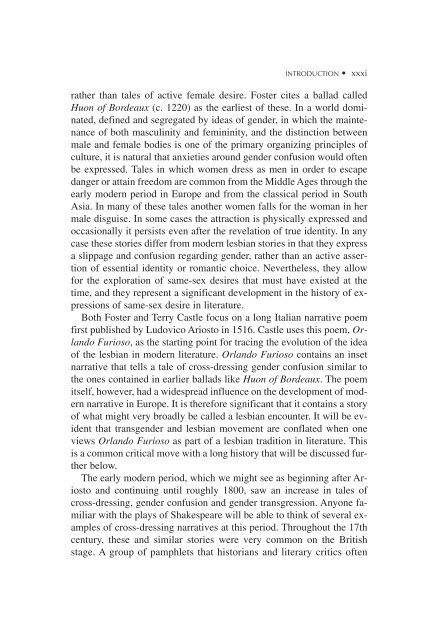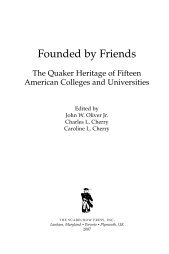Historical Dictionary of Lesbian Literature - Scarecrow Press
Historical Dictionary of Lesbian Literature - Scarecrow Press
Historical Dictionary of Lesbian Literature - Scarecrow Press
You also want an ePaper? Increase the reach of your titles
YUMPU automatically turns print PDFs into web optimized ePapers that Google loves.
INTRODUCTION • xxxi<br />
rather than tales <strong>of</strong> active female desire. Foster cites a ballad called<br />
Huon <strong>of</strong> Bordeaux (c. 1220) as the earliest <strong>of</strong> these. In a world dominated,<br />
defined and segregated by ideas <strong>of</strong> gender, in which the maintenance<br />
<strong>of</strong> both masculinity and femininity, and the distinction between<br />
male and female bodies is one <strong>of</strong> the primary organizing principles <strong>of</strong><br />
culture, it is natural that anxieties around gender confusion would <strong>of</strong>ten<br />
be expressed. Tales in which women dress as men in order to escape<br />
danger or attain freedom are common from the Middle Ages through the<br />
early modern period in Europe and from the classical period in South<br />
Asia. In many <strong>of</strong> these tales another women falls for the woman in her<br />
male disguise. In some cases the attraction is physically expressed and<br />
occasionally it persists even after the revelation <strong>of</strong> true identity. In any<br />
case these stories differ from modern lesbian stories in that they express<br />
a slippage and confusion regarding gender, rather than an active assertion<br />
<strong>of</strong> essential identity or romantic choice. Nevertheless, they allow<br />
for the exploration <strong>of</strong> same-sex desires that must have existed at the<br />
time, and they represent a significant development in the history <strong>of</strong> expressions<br />
<strong>of</strong> same-sex desire in literature.<br />
Both Foster and Terry Castle focus on a long Italian narrative poem<br />
first published by Ludovico Ariosto in 1516. Castle uses this poem, Orlando<br />
Furioso, as the starting point for tracing the evolution <strong>of</strong> the idea<br />
<strong>of</strong> the lesbian in modern literature. Orlando Furioso contains an inset<br />
narrative that tells a tale <strong>of</strong> cross-dressing gender confusion similar to<br />
the ones contained in earlier ballads like Huon <strong>of</strong> Bordeaux. The poem<br />
itself, however, had a widespread influence on the development <strong>of</strong> modern<br />
narrative in Europe. It is therefore significant that it contains a story<br />
<strong>of</strong> what might very broadly be called a lesbian encounter. It will be evident<br />
that transgender and lesbian movement are conflated when one<br />
views Orlando Furioso as part <strong>of</strong> a lesbian tradition in literature. This<br />
is a common critical move with a long history that will be discussed further<br />
below.<br />
The early modern period, which we might see as beginning after Ariosto<br />
and continuing until roughly 1800, saw an increase in tales <strong>of</strong><br />
cross-dressing, gender confusion and gender transgression. Anyone familiar<br />
with the plays <strong>of</strong> Shakespeare will be able to think <strong>of</strong> several examples<br />
<strong>of</strong> cross-dressing narratives at this period. Throughout the 17th<br />
century, these and similar stories were very common on the British<br />
stage. A group <strong>of</strong> pamphlets that historians and literary critics <strong>of</strong>ten
















